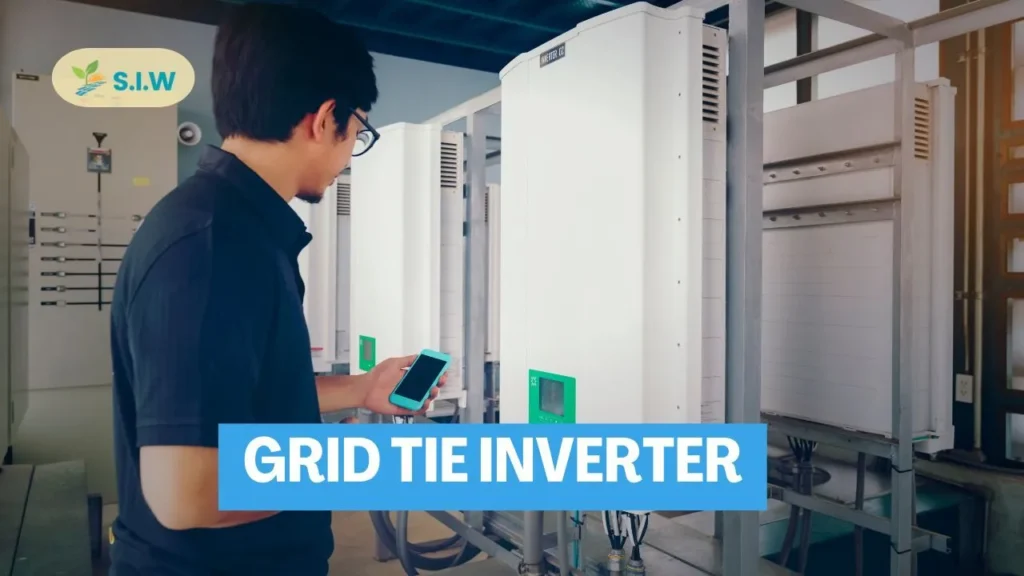Grid-tie inverters are crucial components in modern renewable energy systems, allowing for efficient integration of solar and wind power into the electrical grid. This article delves into the function, benefits, and considerations of grid-tie inverters, providing a detailed understanding of their role in sustainable energy.
What is a Grid-Tie Inverter?
Definition and Purpose
A grid-tie inverter, also known as a grid-connected inverter, is a device that converts the direct current (DC) produced by renewable energy sources like commercial solar panels or wind turbines into alternating current (AC) that is compatible with the electrical grid. Its primary function is to ensure that the energy generated by these sources can be safely and efficiently fed into the public power grid.
How It Works
- DC to AC Conversion: Solar panels and wind turbines generate DC electricity. The grid-tie inverter converts this DC electricity into AC electricity, which is necessary for grid compatibility.
- Synchronization with Grid: The inverter synchronizes the phase, frequency, and voltage of the AC electricity with that of the grid to ensure a smooth and safe flow of energy.
- Power Optimization: Advanced grid-tie inverters use Maximum Power Point Tracking (MPPT) technology to optimize the energy output from renewable sources, ensuring that the maximum possible amount of energy is captured and converted.
Benefits of Grid-Tie Inverters
Efficient Energy Utilization
Grid-tie inverters allow for efficient use of the energy generated by renewable sources. By converting DC power to AC power, they enable the integration of this renewable energy into the existing power grid, maximizing the utility of generated energy.
Cost-Effectiveness
Investing in a grid-tie inverter can be more cost-effective than other systems. Since grid-tie inverters do not require battery storage, they eliminate the need for costly battery banks and their associated maintenance. This makes them an economical choice for many renewable energy systems.
Reduces Electricity Bills
By feeding excess energy back into the grid, homeowners and businesses can benefit from net metering policies, where they receive credit for the surplus energy they contribute. This can significantly reduce electricity bills, making grid-tie inverters a financially attractive option.
Environmental Impact
Grid-tie inverters facilitate the use of renewable energy sources, which helps in reducing the reliance on fossil fuels and decreasing greenhouse gas emissions. This contributes to a more sustainable and environmentally friendly energy system.
Types of Grid-Tie Inverters
String Inverters
String inverters are the most common type of grid-tie inverters. They connect a series of solar panels (a string) and convert the combined DC output into AC. These inverters are generally cost-effective and straightforward, making them a popular choice for residential and small commercial systems.
Microinverters
Microinverters are installed on each individual solar panel, allowing for independent operation and optimization of each panel’s output. This can be beneficial in situations where shading or panel orientation varies. Microinverters offer greater efficiency and flexibility but can be more expensive than string inverters.
Power Optimizers
Power optimizers are devices that work in conjunction with string inverters. They are attached to each solar panel and optimize the DC output before it reaches the inverter. This setup can enhance overall system performance and mitigate issues caused by shading or panel mismatches. Additionally, integrating solar batteries with this system can further improve energy efficiency by storing excess energy for use when sunlight is not available.
Key Features to Consider
Efficiency
The efficiency of a grid-tie inverter is crucial for maximizing the amount of energy converted and fed into the grid. Look for inverters with high efficiency ratings to ensure optimal performance.
Reliability
Reliability is important for maintaining consistent energy production and minimizing downtime. Choose inverters from reputable manufacturers with a track record of reliability and strong customer support.
Warranty and Support
Inverters are a significant investment, so it’s essential to consider the warranty and support offered. A good warranty can provide peace of mind and protect against potential failures.
Grid Compliance
Ensure that the inverter complies with local grid standards and regulations. Different regions may have specific requirements for grid-tie inverters, so verify that the inverter meets these criteria.
Installation and Maintenance
Professional Installation
Proper installation is critical for the safe and efficient operation of a grid-tie inverter. It is recommended to have the inverter installed by a certified professional who is familiar with local regulations and safety standards.
Regular Maintenance
While grid-tie inverters are generally low-maintenance, regular inspections are important to ensure optimal performance. Check for any signs of wear or damage and ensure that the inverter is functioning correctly.
Common Issues and Troubleshooting
Overheating
Overheating can reduce the efficiency of the inverter and potentially cause damage. Ensure that the inverter is installed in a well-ventilated area and monitor its temperature regularly.
Grid Outages
During a grid outage, grid-tie inverters will typically shut down to prevent back-feeding electricity into the grid. This is a safety feature to protect utility workers. Some systems include battery backup to maintain power during outages.
Performance Issues
If the inverter is not performing as expected, check for common issues such as loose connections, shading on solar panels, or faults in the system. Regular maintenance and monitoring can help identify and resolve performance issues.
Conclusion
Grid-tie inverters play a pivotal role in modern renewable energy systems, enabling the efficient conversion and integration of renewable energy into the electrical grid. By understanding their function, benefits, types, and maintenance requirements, you can make informed decisions about incorporating them into your energy system. Whether for residential, commercial, or industrial applications, grid-tie inverters offer a practical and cost-effective solution for harnessing renewable energy and contributing to a more sustainable future.








